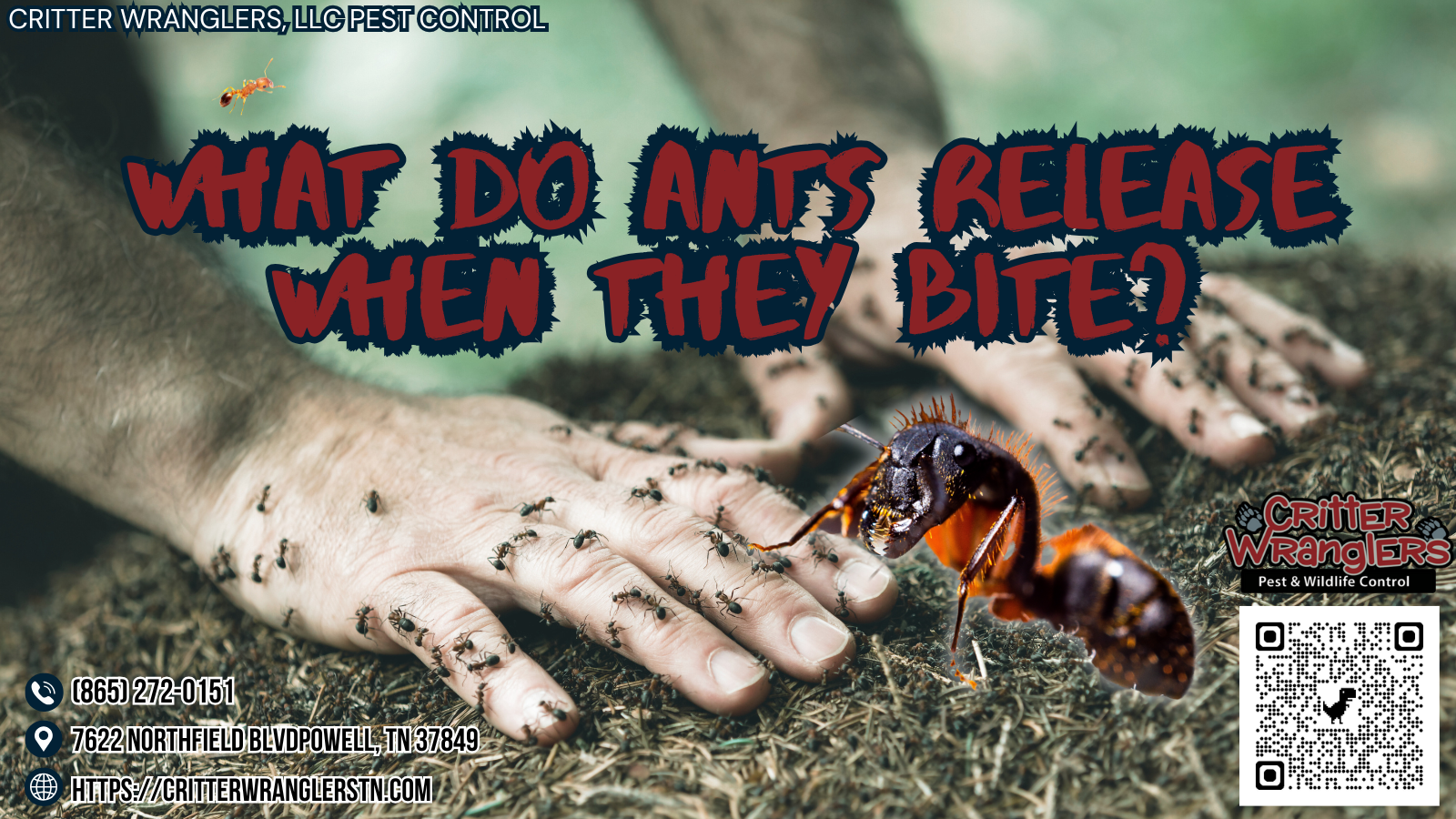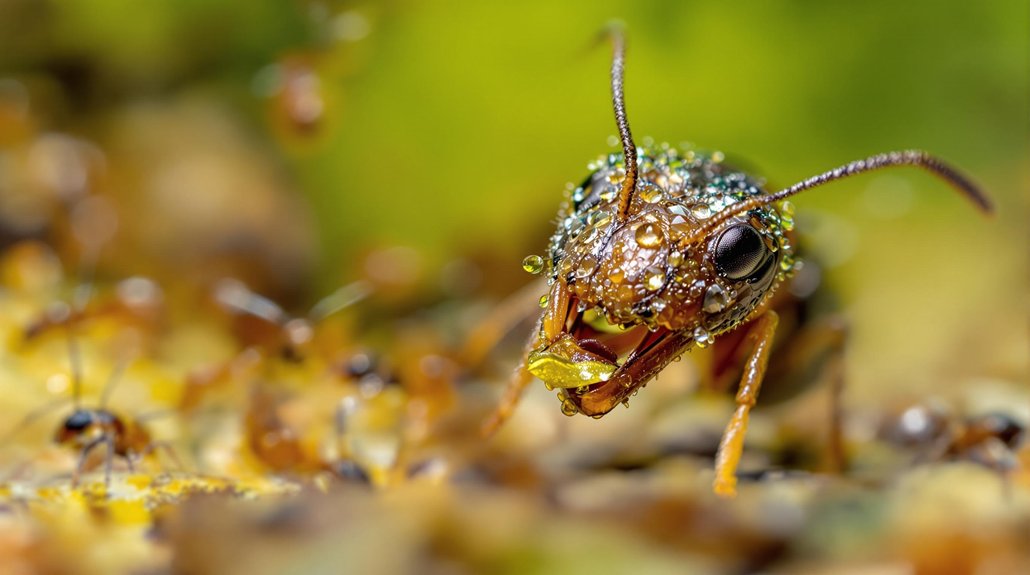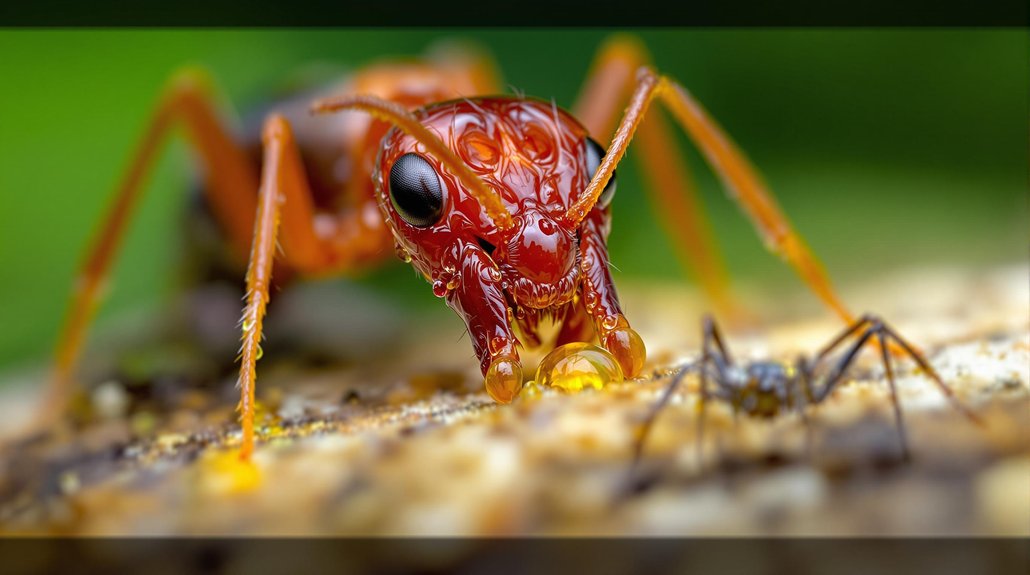Critter Wranglers, LLC Blog
Have an issue? Contact us today

What Do Ants Release When They Bite?
When ants bite, they release saliva, venom, and alarm pheromones. Saliva helps break down food, while venom can immobilize prey or defend against threats. The alarm pheromones signal other ants in the colony to respond to danger. This combination enhances their ability to protect their communities and communicate effectively. Each ant species has unique biting techniques that serve various ecological roles. Exploring these methods reveals fascinating insights into their survival strategies and social structure.
Key Article Highlights
- Ants may inject venom through their bites, which can cause pain or immobilization of their targets.
- Venom contains neurotoxins, proteins, enzymes, and allergens that trigger various reactions.
- Alarm pheromones are released to signal distress, alerting other colony members to potential threats.
- The combination of physical bites and chemical signals enhances their defense mechanisms against predators.
- Different ant species have unique venom compositions, affecting the severity of the bite's effects.
The Anatomy of an Ant Bite
An ant bite can be an unpleasant experience for many. Understanding the anatomy and biting mechanics of ants provides insight into this phenomenon. Ants possess specialized mouthparts called mandibles, which function like jaws. These mandibles allow ants to grasp and pierce their target. When an ant bites, it uses its mandibles to clamp down, creating an opening in the skin. The biting mechanics involve a precise movement that delivers pressure, causing discomfort. Additionally, some ants may use their sharp stingers to inject venom, further enhancing the pain. The combination of mandible action and possible venom delivery makes an ant bite particularly effective. Mastery of this knowledge can help individuals better understand the impact of an ant bite.
Chemical Weapons: The Role of Venom
Venom serves as a powerful weapon for many ant species, enhancing their ability to defend themselves and subdue prey. These ants utilize venomous compounds in their bites, which can immobilize or even kill their targets. The biting behavior of ants is not just a means of feeding; it is also a strategic move in their survival.
Ants wield venom not only for feeding but as a vital survival strategy, immobilizing and overpowering their prey.
Key characteristics of ant venom include:
- Neurotoxins: Disrupt nerve function in prey.
- Proteins: Cause pain and swelling in attackers.
- Digestive enzymes: Break down tissue for easier consumption.
- Allergens: Trigger allergic reactions in larger predators.
Each component plays a significant role in the ant's ability to thrive in various ecosystems, showcasing the intricate design of nature's chemical weapons.
Alarm Pheromones: Calling for Reinforcements

When faced with danger, ants possess a remarkable ability to communicate through alarm pheromones, which serve as a distress signal to fellow colony members. These chemical signals trigger immediate responses, alerting nearby ants to potential threats. Upon detecting danger, an ant releases alarm signals that can travel through the air or on surfaces, effectively reaching others in the colony. This quick communication initiates recruitment strategies, as alerted ants rush to the source of the threat to defend their home. The efficiency of alarm pheromones enhances the colony's survival, allowing for coordinated actions against predators. Through this advanced form of communication, ants exemplify teamwork, ensuring that each member plays a role in the colony's defense.
Defense Mechanisms: A Multi-Layered Approach
Although threats to their colonies can vary widely, ants employ a multi-layered approach to defense that enhances their chances of survival. This strategy involves several key elements:
- Alarm pheromones: When a colony is threatened, ants release chemicals to alert others.
- Biting behavior: Many ants bite to defend their territory, using their strong jaws to deter intruders.
- Ant aggression: Some species display aggressive behaviors, swarming and attacking potential predators in large numbers.
- Nest construction: Ants build intricate nests that provide shelter and protection against threats.
These coordinated responses reflect the complexity of ant behavior, ensuring that colonies remain resilient against various dangers. By utilizing these mechanisms, ants effectively safeguard their community.
The Impact of Ant Bites on Predators

Ant bites can have a significant impact on their predators. The venom composition of different ant species can cause various reactions in animals that attempt to eat them. Understanding these predator response mechanisms helps to highlight the ecological role ants play in their environments.
Ant Venom Composition
Venom serves as an essential defense mechanism for many ant species, impacting their interactions with predators. Ant toxins vary widely, showcasing the evolution of venom in response to environmental pressures. These toxins can deter or incapacitate potential threats, ensuring the ant's survival. Key components of ant venom include:
- Proteins – disrupt cellular functions and can cause pain.
- Alkaloids – create discomfort, deterring larger predators.
- Peptides – inhibit nerve signals, leading to paralysis.
- Enzymes – break down tissues, aiding in predation or defense.
Understanding the complexity of ant venom composition highlights its role in venom evolution. Such adaptations demonstrate how ant toxins have developed to effectively protect ants from various predators, ensuring their continued existence in diverse ecosystems.
Predator Response Mechanisms
When predators encounter an aggressive ant, they often experience a swift and painful reaction. This response greatly influences predator behavior. Ant bites can cause immediate discomfort, leading predators to reconsider their approach or avoid attacking altogether. The frequency of ant bites can vary depending on the species and the level of threat perceived by the ants. For example, when threatened, some ants may bite repeatedly, increasing the likelihood of deterring larger predators. This defensive mechanism not only protects the ants but can also alter the feeding patterns of their predators. Consequently, the pain and irritation from ant bites can lead to a decline in predation rates, demonstrating the complex interactions between ants and their potential threats.
Ecological Impact of Ants
Although often overlooked, the ecological impact of ants extends beyond their immediate environment to influence various predator species. Ants play a vital role in ecosystems, affecting predator behaviors and population dynamics. Their bites can deter potential threats, influencing food chain interactions. Key impacts include:
- Chemical Signals: Ants release alarm pheromones that warn predators.
- Predator Avoidance: Many species learn to avoid areas populated by aggressive ants.
- Biodiversity: Ants contribute to habitat preservation, supporting various organisms.
- Nutrient Cycling: Ants help decompose organic matter, enriching the soil.
Understanding ant population dynamics and advocating for ant habitat preservation is essential for maintaining ecological balance. This awareness can help protect not only ants but also the diverse species that rely on them.
Ecological Significance of Ant Defense Strategies
Ants use various defense strategies to protect their colonies, including chemical warfare. These strategies play a crucial role in maintaining the balance of ecosystems. Understanding how ants defend themselves helps reveal their importance in nature.
Ant Chemical Warfare
Engaging in a complex form of warfare, ants utilize chemical signals to defend their colonies. This strategy enhances ant aggression and guarantees survival against threats. Through chemical communication, ants can coordinate their defenses effectively. They employ various chemicals for different purposes, including:
- Alarm pheromones that signal danger to nearby ants.
- Trail pheromones that guide colony members towards food or away from threats.
- Defensive secretions that can deter predators or rival ants.
- Recruitment signals that summon additional workers for a collective response.
These chemical strategies are vital for maintaining the integrity of the colony and showcasing the strength of their social structure. By mastering these chemical warfare tactics, ants guarantee their continued dominance in their environments.
Role in Ecosystems
While many may focus on the individual behaviors of ants, their role in ecosystems is profoundly influenced by their defense strategies. Ant interactions are essential for maintaining ecosystem balance. When ants defend their colonies, they impact the populations of other species, including pests and predators. This regulation helps prevent any one species from overwhelming the environment. Additionally, ants contribute to soil health by aerating it and aiding in decomposition, which nourishes plants. Their defense mechanisms, such as biting or releasing chemicals, deter threats and protect their resources. This not only guarantees their survival but also supports other organisms within their habitat. Consequently, the defense strategies of ants play a critical role in sustaining ecological harmony and diversity.
Ant Species and Their Unique Biting Techniques
A diverse array of ant species showcases unique biting techniques that serve various purposes in their ecosystems. These biting techniques are vital for survival, protection, and communication among ants.
Ants exhibit diverse biting techniques essential for survival, protection, and communication within their ecosystems.
- Fire Ants: Known for their painful bites, they also inject venom to deter predators.
- Leafcutter Ants: Use their strong jaws to cut leaves, aiding in their fungal farming.
- Army Ants: Employ biting as a coordinated defense mechanism, overwhelming threats as a group.
- Carpenter Ants: Utilize their bites to excavate wood, creating nesting sites.
Each of these ant species demonstrates that biting techniques are not just about aggression but are significant for their survival and roles within their environments. Understanding these methods enhances our appreciation of ant behavior.
Frequently Asked Questions
Do All Ant Species Bite or Only Specific Ones?
Not all ant species exhibit biting behavior; some prefer to use stingers or other methods of defense. While aggressive species bite to protect their nests, others rely on cooperation and alternative strategies for survival.
How Painful Is an Ant Bite Compared to a Bee Sting?
The ant bite intensity varies by species, generally causing mild to moderate pain. In bee sting comparison, ant bites are often less severe, although certain species can deliver surprisingly painful bites that rival bee stings.
Can Ants Bite Without Injecting Venom?
Ants possess remarkable bite mechanics that allow them to grip and hold onto prey. While most ant species inject venom through their bites, some can bite without venom, relying solely on their powerful mandibles for defense or feeding.
What Are Common Allergic Reactions to Ant Bites?
Common allergic reactions to ant bites include redness, swelling, itching, and pain. In more severe cases, individuals may experience hives or anaphylaxis. Recognizing these allergy symptoms is essential for timely treatment of bite reactions.
How Can I Treat an Ant Bite Effectively?
To treat an ant bite effectively, individuals can apply home remedies like ice or aloe vera. Additionally, practicing bite prevention, such as wearing protective clothing and avoiding ant-infested areas, helps reduce the likelihood of future bites.
